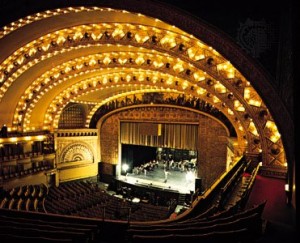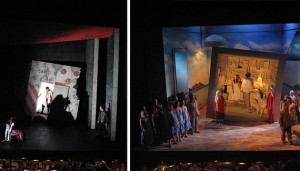Annotated Bibliography 6 : Unit Two
“Resources_IdeasInfo_typesandformsoftheatre.pdf.” Web. 20 Feb. 2016.
In their article, “Types and Forms of Theatre”, Theatre Projects Consultants, a group of specialists who build performance spaces, claim that, “There is no ideal size of a theatre [because] the scale of a theatre depends on the size of the staging required by the type of performance and the number of audience to be accommodated, with each variable influencing the other as they change.” To support their claim, they explain the different types of performance spaces and the purpose of each type. The types of spaces they describe are drama, music, opera, dance,multipurpose, worship, teaching, media interaction and entertainment. To further explain, they give detailed descriptions of each type and provide examples of these theaters from various cities. The purpose of this article is to explain the different types of theater set-ups and their purposes. It will be a useful source to someone that wants to know about how the function of a theater influences its design.
Annotated Bibliography 5: Unit Two
“Theatre Design – The Goals of Theatre Design | Architecture.” Encyclopedia Britannica. N.p., n.d. Web. 19 Feb. 2016.
In their article, “Theatre Design – The Goals of Theatre Design”, the editors of Encyclopedia Britannica, a global educational publisher, they claim that “Theatre design is primarily concerned with enhancing the experience the audience can have at a performance [and] the specific architectural elements considered ideal for improving that experience will differ from culture to culture and sometimes even between subcultures within a given culture.” To support this claim, they describe two different categories of elements in a design, each being used for a different purpose. The two categories are “those that serve the aesthetics deemed appropriate for the art of theatre in a given culture, and those that optimize the experience of that art for the audience.” In the article they provide information on each of them, stating that “Those elements that serve the aesthetics of the art of theatre can involve everything from what the performers need to reach the artistic standards deemed proper before a performance starts to what they need to support the required amount of spectacle during performance, whether it be a bare stage or a stage with enormous movable sets and a spectacular array of props.” In contrast, “The elements that are most often discussed in terms of optimizing the experience had by the audience revolve around audience comfort”. Then they explain which areas of the theatre fit in each category. They state that, “those elements of a theatre’s design that serve primarily to optimize the experience of the audience are the house and the… ‘front-of-house’ facilities” and “those elements of the design of a theatre that serve primarily the aesthetics of theatre performance are the stage and the…backstage spaces”. They then describe each area in detail. The purpose of this article is to provide information on the purposes of theater design. This will be a useful source for someone that is interested in finding out why theaters are designed a certain way.
Annotated Bibliography 4: Unit Two
Lehman, Maria Lorena. “Take Note When Experiencing Theater Set Design.” Sensing Architecture ® Academy | Maria Lorena Lehman. N.p., 7 Dec. 2009. Web. 20 Feb. 2016.
In her article, “Take Note When Experiencing Theater Set Design”, Maria Lehman, an architectural author, designer and educator, claims that “theater set design must work to create an experience with space, and often such theatrical experiences tap into so much more that just the visual sense.” To support her claim, she gives explains how the environment of the theater set is used to engage the audience in the show. In the article, Lehman states that ” a theater stage (say for a musical) can be perceived as a micro-environment in that it must accomplish a lot with a little amount of space.” She suggests architects to consider how the limited space of the stage affects the transitions in a performance. The purpose of this article is to raise encourage architects to “keep in mind how the set design experience really caters to the senses.” This would be a useful source to someone that is interested in learning about the importance of the set up of the stage in a theater and how the size of the stage affects the performance.

